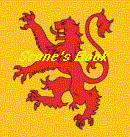


 |


 |
The pagan Celts got some things right. When the grey monotony and darkness of a Scottish winter enveloped the land, the natives punctuated the frigid season with the fire festivals and the great feasts. Today's Scottish festival of Hogmanay has ancient origins in the winter solstice, when the sun gradually returned after the shortest day, bringing with it warmth and the renewal of spring.
Before the reformation of the 16th century put a damper on people's communal celebrations, Scottish society, rich and poor alike, indulged in the 12 days of mid-winter "bacchanalia". Called "Daft Days," the revelry can be traced to Rome's Saturnalia and the Norse festival of Yule. During these Daft Days, society was turned upside down: profane songs were sung in churches, nobles were mocked, and drinking and feasting prevailed. The fun ended with the festival of Uphalieday on the Twelfth Night of Christmas.
The Scots still manage to do their ancestors proud with Hogmanay, the great New Year's Eve festival. In days gone by, bonfires were lit and gifts were exchanged (the word Hogmanay is possibly related to an old French dialect word meaning a gift at new year, or may be derived from "au geux menez", which means "bringing games").
Hogmanay in Scotland is a festival of renewal, an opportunity to cast off bad luck and hardship, to renew friendships and hope. In more recent times, all debts were paid off, borrowed articles were returned before the New Year, and homes were thoroughly cleaned.
The rituals and ceremonies of Hogmanay have continued for thousands of years. There are still fire festivals in some Scottish communities. And although much of the celebrating takes place in Scottish homes, it is still the custom in towns and cities to gather at the mercat (market)cross to publicly welcome the New Year at midnight. Flasks of whiskey are passed around and New Year's greetings are exchanged after the bells have struck. Auld Lang Syne is sung, and the crowd disperses for the ritual of the first-footing: bringing in the New Year with friends and family, and sharing a dram (or two) from their bottle of whiskey.
Presented by:
Scone
Nancy MacCorkill, F.S.A. Scot USA
Author, Poet,
Historian of the Ancient Clans of Scotland,
Researcher in Dept of Celt
 |
 |
©Page designed by Created by Dreamspinner©, Webmaster
"©All Rights Reserved for ©Scone's Scottish & Celtic Internet Book 6/15/2001 N MacCorkill©"
Exception: when presenting another author's material.©